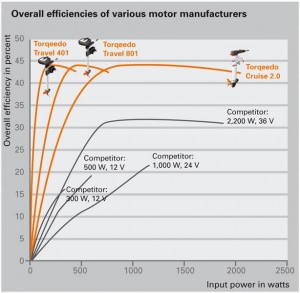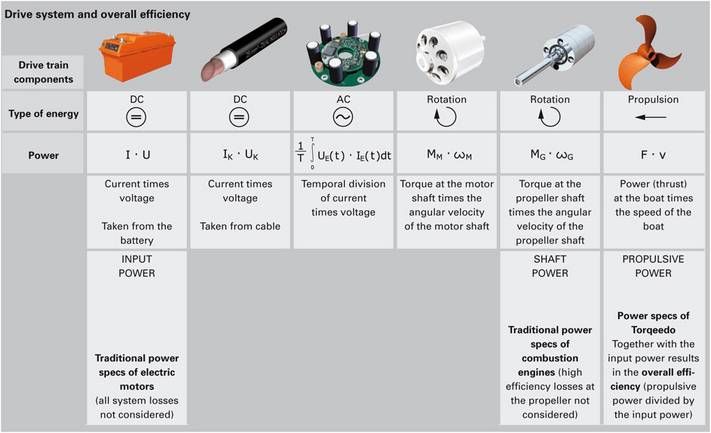Meaningful performance indicators
Torqeedo provides meaningful performance indicators for boat drives. Basically, the power of a drive is measured according to how much propulsion it actually delivers for moving the boat. This power is referred to as the output or propulsive power. It is calculated by the power times the speed and can be expressed in watts or horsepower.
Although the propulsive power forms an extremely informative index for boat drives, most manufacturers don’t provide it.
Suppliers of electric motors generally use the input power of their motors as the power rating. However, only a fraction of this value is actually available to the boat drive as propulsive power. The rest is lost – for example in the motor or propeller – as inefficiency. Manufacturers of combustion engines, on the other hand, usually give the power at the motor shaft as their index. Also here, only a fraction of this value is available as propulsive power:
Propellers on combustion engines of a lower power class cause some 70% of the motor shaft power to be lost as inefficiency that cannot be converted to propulsion.
The second important index is the overall efficiency. It describes the efficiency with which the drive system converts the available energy sources into output power and is calculated by dividing the propulsive power by the input power.
Torqeedo builds the most efficient outboards on the market by far, by means of consistent orientation towards propulsive power and overall efficiency. As the overall efficiency of a drive system is given by the product of the partial efficiency levels of all components, a single poor partial-efficiency level can have a significant negative influence on overall efficiency. For this reason, Torqeedo takes great care in the comprehensive optimization and interaction of all components.
Another commonly used motor index is the static thrust expressed in pound force (lbf) or Newton (N). In comparison to the propulsive power and overall efficiency, this index is less meaningful, as it only measures propulsion in association with the static bollard pull experiment. In this case, as the speed is zero, the effective power (power times speed) is also zero. As a consequence to this, the static thrust does not provide any information on the propulsive power that can be actually achieved and is therefore not a meaningful index when taken in isolation. It merely serves as an indication for the maximum boat size that the motor can be used on. Before purchasing a motor, it is recommendable to test the static thrust specifications
personally. In Torqeedo’s tests of competitor products, the manufacturers’ specified static thrust values could generally not be reproduced.
Manufacturers‘ specifications and test results of electric boat motors
| Product | Maximum input power in operation (electromotors) in watts |
Maximum motor shaft power (combustion engines) in watts |
Maximum propulsive power in watts |
Maximum overall efficiency of electric motors in percent |
Maximum propeller efficiency of internal combustion engines in percent |
Static thrust in pound force | Comments |
| Torqeedo Travel 401 |
400 | 175 | 44 % | 40 | |||
| Torqeedo Travel 801 |
800 | 350 | 44 % | 68 | |||
| Torqeedo Cruise 2.0 |
2000 | 900 | 45 % | 121 | |||
| Competitor 300W & 12V |
300 | 60 | 20 % | 20 | |||
| Competitor 500W & 12V |
500 | 100 | 20 % | 35 | Manufacturer’s specifications of static thrust: 55 lbf | ||
| Competitor 1000W & 24V |
1000 | 190 | 19 % | 55 | Manufacturer’s specifications of static thrust: 80 lbf | ||
| Competitor 2200W & 36V |
1800 | 600 | 33 % | 88 | |||
| Competitor 2.3PS / 4-Takt |
1690 | 380 | 22 % | 55 | |||
| Competitor 4PS / 2-Takt |
2940 | 700 | 24 % | 71 | |||
| Competitor 6PS / 4-Takt |
4410 | 1200 | 27 % | 112 |
A big test for small motors: Accredited test laboratory Potsdam Model Basin (SVA Potsdam) confirms unique efficiency of Torqeedo outboards.
After successful internal tests and a successful introduction of the motors onto the market in Germany, Austria and Switzerland, Torqeedo wanted to have an “ultimate” test and sent two of its outboards to the SVA Potsdam. The independent experts at the SVA tested and confirmed the unique overall efficiency level and superior propulsive powers of the Torqeedo motors under laboratory conditions.
Since its founding more than 50 years ago, the SVA has developed into an internationally recognized research and consultation facility for commercial shipbuilding. 45 highly-specialized experts from various fields as well as test systems and measurement techniques that meet all international standards consolidate the position of this non-profit-making organization as an internationally recognized research center and accredited test laboratory.




